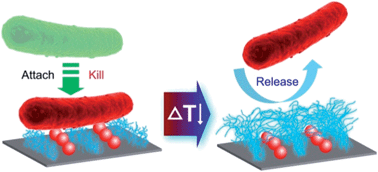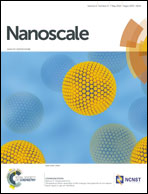Nanopatterned antimicrobial enzymatic surfaces combining biocidal and fouling release properties†
Abstract
Surfaces incorporating the antimicrobial enzyme, lysozyme, have been previously demonstrated to effectively disrupt bacterial cellular envelopes. As with any surface active antimicrobial, however, lysozyme-expressing surfaces become limited in their utility by the accumulation of dead bacteria and debris. Surfaces modified with environmentally responsive polymers, on the other hand, have been shown to reversibly attach and release both live and dead bacterial cells. In this work, we combine the antimicrobial activity of lysozyme with the fouling release capability of the thermally responsive polymer, poly(N-isopropylacrylamide) (PNIPAAm), which has a lower critical solution temperature (LCST) in water at ∼32 °C. Nanopatterned PNIPAAm brushes were fabricated using interferometric lithography followed by surface-initiated polymerization. Lysozyme was then adsorbed into the polymer-free regions of the substrate between the brushes to achieve a hybrid surface with switchable antimicrobial activity and fouling-release ability in response to the change of temperature. The temperature triggered hydration and conformational change of the nanopatterned PNIPAAm brushes provide the ability to temporally regulate the spatial concealment and exposure of adsorbed lysozyme. The biocidal efficacy and release properties of the hybrid surface were tested against Escherichia coli K12 and Staphylococcus epidermidis. The hybrid surfaces facilitated the attachment of bacteria at 37 °C for E. coli and 25 °C for S. epidermidis and when the temperature is above the LCST, collapsed and dehydrated PNIPAAm chains expose lysozyme to kill attached bacteria. Changing temperature across the LCST of PNIPAAm (e.g. from 37 °C to 25 °C for E. coli or from 25 °C to 37 °C for S. epidermidis) to induce a hydration transition of PNIPAAm promoted the release of dead bacteria and debris from the surfaces upon mild shearing. These results suggest that nano-engineered surfaces can provide an effective way for actively mitigating short term bacterial biofouling.


 Please wait while we load your content...
Please wait while we load your content...